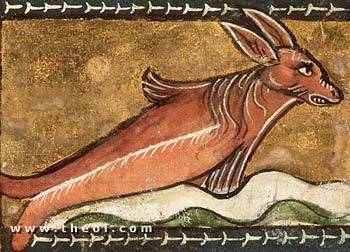KETEA INDIKOI
Greek Name
Κετος
Ινδικος
Κετεα Ινδικοι
Transliteration
Ketos Indikos
Ketea Indikoi
Latin Spelling
Cetus Indicus
Cetea Indici
Translation
Indian Sea-Monster
Indian Sea-Monsters

THE KETEA INDIKOI (Indian Cetea) were fabulous, multi-formed sea-monsters believed to inhabit the Indian Ocean. They had the foreparts of land animals--such as lions, leopards, rams and wolves--and the serpentine tails of fish.
The Ketea also included a breed of mermaid-like creatures with the heads of women, the tails of fish, and sharp spines for hair.
The Ketea were closely related to the Hippokampoi (Fish-Tailed Horses) and Tritones of Greek myth.
CLASSICAL LITERATURE QUOTES
Aelian, On Animals 16. 18 (trans. Scholfield) (Greek natural history C2nd A.D.)
:
"Those [the Indians of Taprobane, perhaps modern-day Sri Lanka)] that live near to the sea . . . devote
themselves to catching fish and sea-monsters (ketea). For they assert that the sea which surrounds the
circuit of their island breeds a multitude past numbering of fishes and monsters, and moreover that they have
the heads of lions and leopards and wolves and rams, and, still more wonderful to relate, that there are some
which have the forms of Satyroi (Satyrs) with the faces of women, and these have spines attached in place of
hair. They tell of others too which have strange forms whose appearance not even men skilled in painting and in
combining bodies of diverse shapes to make one marvel at the sight, could portray with accuracy or represent for
all of their artistic skill; for these creatures have immense and coiling tails, while for feet they have claws
or fins. I learn too that they are amphibious and that at night they graze the fields, for they eat the grass as
cattle and rooks do; they enjoy the ripe fruit of the date-palm and therefore shake the trees with their coils,
which being supple and capable of embracing, they fling round them. So when the shower of dates has fallen
because of this violent shaking, they feed upon it. And then as the night wanes and before it is clear daylight
these creatures plunge into the ocean and disappear as the dawn begins to glow."
SOURCES
GREEK
- Aelian, On Animals - Greek Natural History C2nd - 3rd A.D.
BIBLIOGRAPHY
A complete bibliography of the translations quoted on this page.